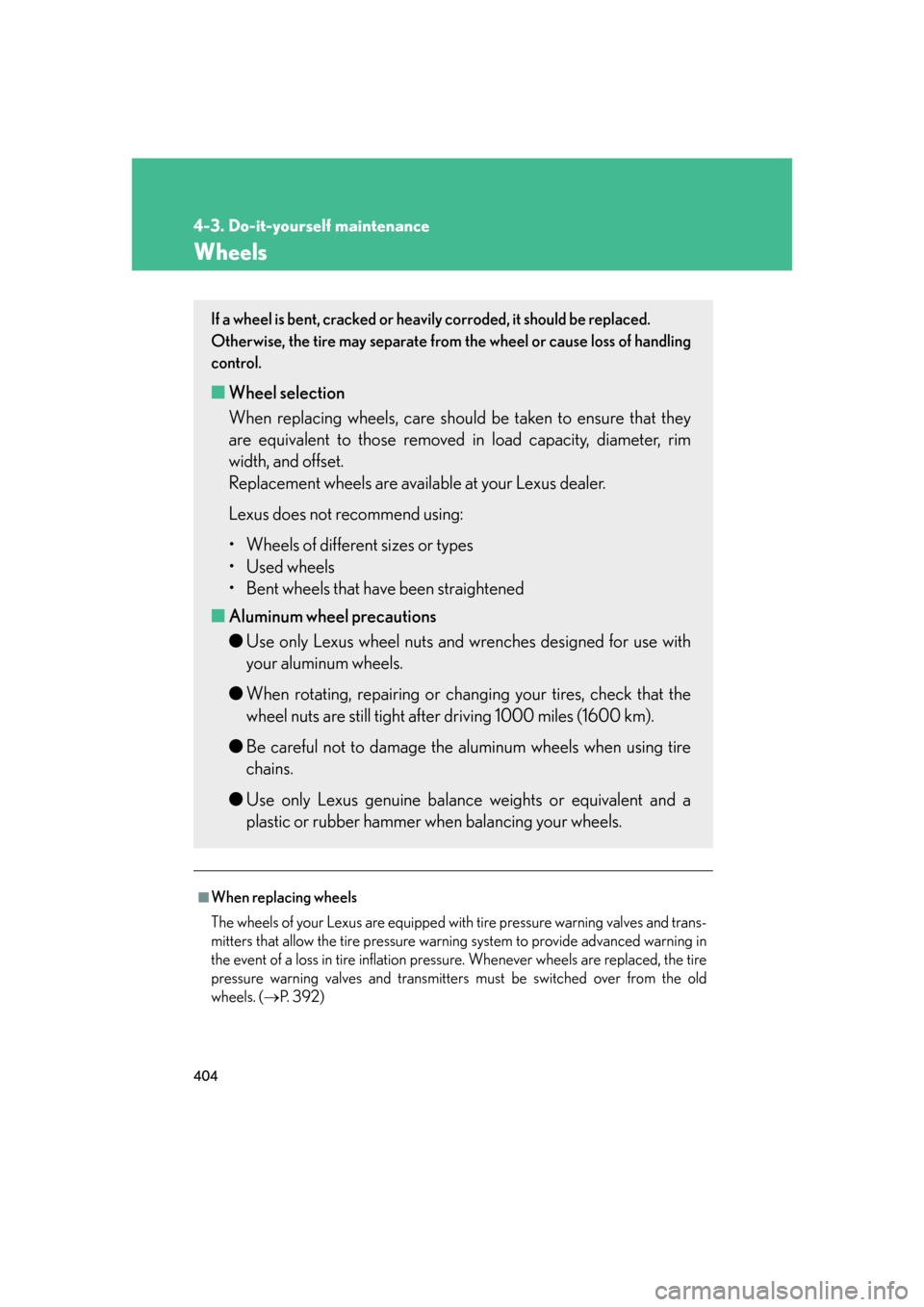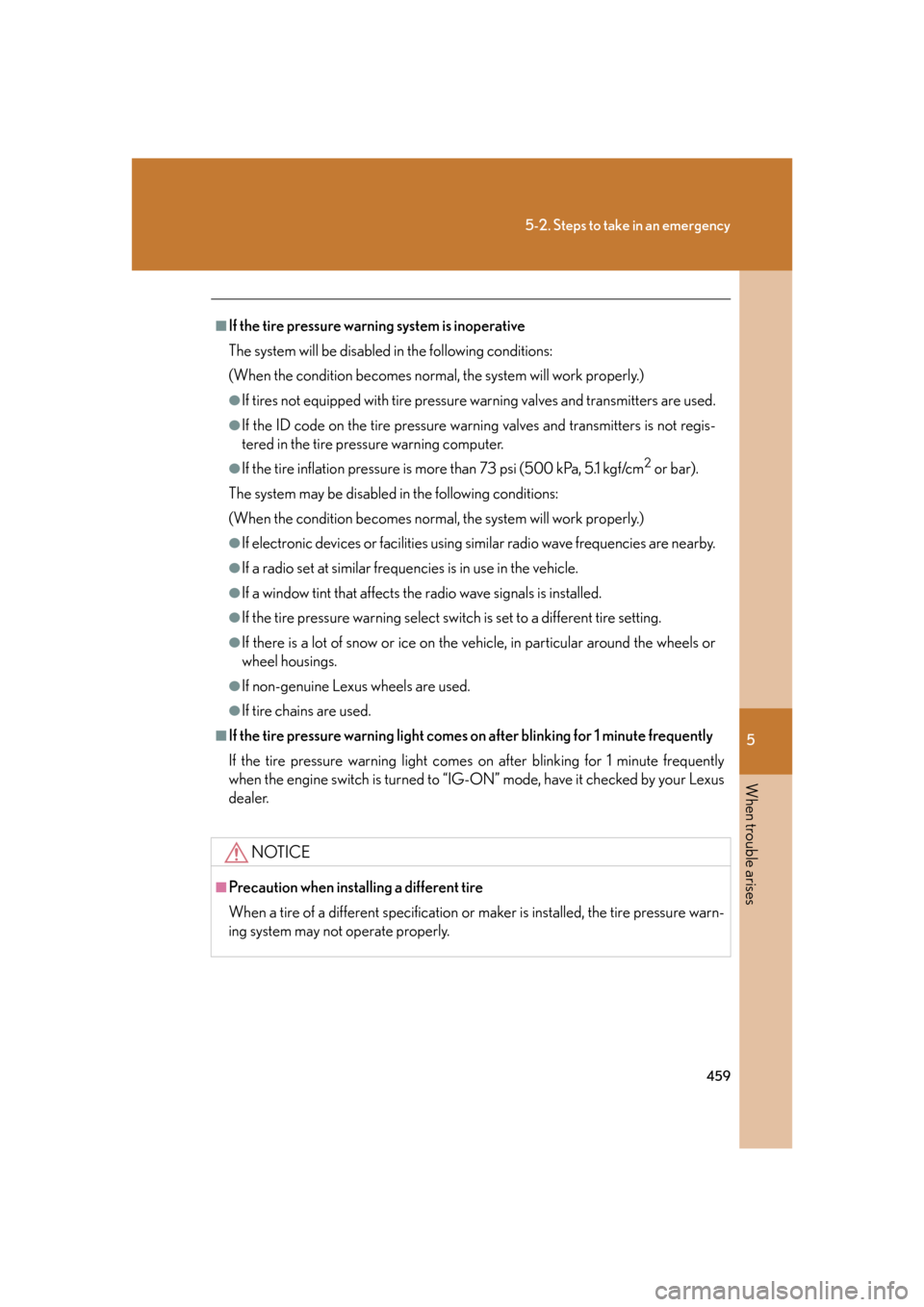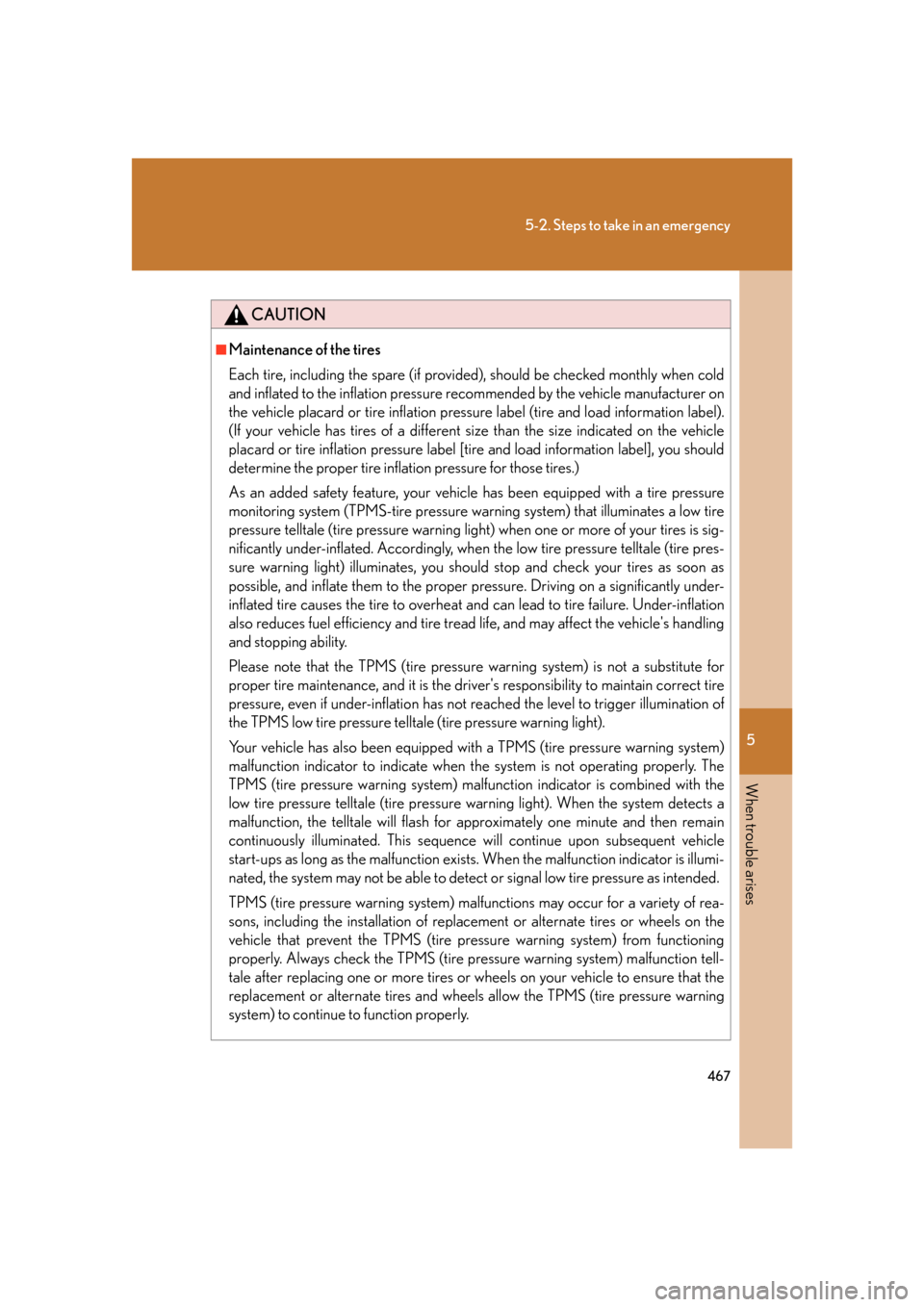tires Lexus GS350 2007 Using the front audio system / LEXUS 2007 GS430/350 (OM30A04U) Owner's Guide
[x] Cancel search | Manufacturer: LEXUS, Model Year: 2007, Model line: GS350, Model: Lexus GS350 2007Pages: 562, PDF Size: 17.95 MB
Page 424 of 562

404
4-3. Do-it-yourself maintenance
Wheels
■When replacing wheels
The wheels of your Lexus are equipped with tire pressure warning valves and trans-
mitters that allow the tire pressure warning system to provide advanced warning in
th
e event of a loss in tire inflation pressu re. Whenever wheels are replaced, the tire
pressure warning valves and transmitters must be switched over from the old
wheels. ( P. 3 9 2 )
If a wheel is bent, cracked or heavily corroded, it should be replaced.
Otherwise, the tire may separate from
the wheel or cause loss of handling
control.
■ Wheel selection
When replacing wheels, care should be taken to ensure that they
ar
e equivalent to those removed in load capacity, diameter, rim
width, and offset.
Replacement wheels are available at your Lexus dealer.
Lexus does not recommend using:
• Wheels of different sizes or types
• Used wheels
• Bent wheels that have been straightened
■ Aluminum wheel pr
ecautions
● Use only L
exus wheel nuts and wr enches designed for use with
your aluminum wheels.
● When r
otating, repairing or changi ng your tires, check that the
wheel nuts are still tight after driving 1000 miles (1600 km).
● Be car
eful not to damage the aluminum wheels when using tire
chains.
● Use only L
exus genuine balance weights or equivalent and a
plastic or rubber hammer when balancing your wheels.
Page 425 of 562

405
4-3. Do-it-yourself maintenance
4
Maintenance and care
CAUTION
■When replacing wheels
●Do not use wheels that are a different size from those recommended in the
Owner’s Manual, as this may result in loss of handling control.
●Never use an inner tube in a leaking wheel which is designed for a tubeless tire.
Doing so may result in an accident, causing death or serious injury.
NOTICE
■Replacing tire pressure warning valves and transmitters
●Because tire repair or replacement may affect the tire pressure warning valves
and transmitters, make sure to have tires serviced by your Lexus dealer. In addi-
tion, make sure to purchase your tire pressure warning valves and transmitters at
your Lexus dealer.
●Ensure that only genuine Lexus wh eels are used on your vehicle.
Tire pressure warning valves and transmitters may not work properly with non-
genuine wheels.
Page 457 of 562

When trouble arises5
437
5-1. Essential information ........... 438If your vehicle needs to be
towed.......................................... 438
If you think something is
wrong .......................................... 445
Fuel pump shut off system ..... 446
Event data recorder ................. 447 5-2. Steps to take in an
emergency............................ 449
If a warning light turns on or a
warning buzzer sounds............ 449
If a warning message is
displayed.................................... 455
If you have a flat tire (Vehicles
with run-flat tires) .................... 472
If you have a flat tire (Vehicles
with standard tires) ................. 473
If the engine will not start ....... 483
If the shift lever cannot be
shifted from P........................... 484
If you lose your keys ................. 485
If the electronic key does
not operate properly ............ 486
If the vehicle battery is discharged ............................... 488
If your vehicle overheats ........ 492
If the vehicle becomes stuck ............................................ 495
Page 465 of 562

5
When trouble arises
445
5-1. Essential information
If you think something is wrong
If you notice any of the following symptoms, your vehicle probably needs
adjustment or repair. Contact your Lexus dealer as soon as possible.
■ Visible symptoms
●Fluid leaks under the v
ehicle
(Water dripping from the air conditioning after use is normal.)
● Flat
-looking tires or uneven tire wear
●Engine coolant temper atur
e gauge needle continually points
higher than normal
■ A
udible symptoms
●Changes in e
xhaust sound
● Ex
cessive tire squeal when cornering
●Str
ange noises related to the suspension system
●P
inging or other noises related to the engine
■ Oper
ational symptoms
●Engine mis
sing, stumbling or running rough
●A
ppreciable loss of power
●V
ehicle pulls heavily to one side when braking
●V
ehicle pulls heavily to one side when driving on a level road
● L
oss of brake effectiveness, sp ongy feeling, pedal almost touches
the floor
Page 474 of 562

454
5-2. Steps to take in an emergency
■When the tire pressure warning light comes on
Check the tire inflation pressure and adjust to the appropriate level. Pushing the tire
pr
essure warning reset switch does not turn off the tire pressure warning light.
■The tire pressure warning light may turn on due to natural causes
The tire pressure warning light may turn on due to natural causes such as natural air
le
aks or tire inflation pressure changes caused by temperature. In this case, adjust -
ing the tire inflation pressure will turn off the warning light.
CAUTION
■If the tire pressure warning light comes on
Be sure to observe the following precautions. Failure to do so could cause loss of
vehicle control and result in death or serious injury.
●Vehicles with run-flat tires:
• Decelerate to the lowest appropriate speed as soon as possible. Do not drive
over 55 mph (90 km/h).
• Check and adjust the tire inflation pressure immediately.
• If the tire pressure warning light comes on even after tire inflation pressure adjustment, it is probable that you have a flat tire. Have the tire replaced by
the nearest Lexus dealer.
• Avoid abrupt maneuvering and braking. If the vehicle tires deteriorate, you
could lose control of the steering wheel or the brakes.
●Vehicles with standard tires:
• Stop your vehicle in a safe place as soon as possible. Adjust the tire inflation pressure immediately.
• If the tire pressure warning light comes on even after tire inflation pressure
adjustment, it is probable that you have a flat tire. Check the tires. If the tire is
flat, change to the spare tire and have the flat tire repaired by the nearest
Lexus dealer.
• Avoid abrupt maneuvering and braking. If the vehicle tires deteriorate, you
could lose control of the steering wheel or the brakes.
■If a blowout or sudden air leakage should occur
The tire pressure warning system may not activate immediately.
Page 479 of 562

5
When trouble arises
459
5-2. Steps to take in an emergency
■If the tire pressure warning system is inoperative
The system will be disabled in th
e following conditions:
(When the condition becomes normal, the system will work properly.)
●If tires not equipped with tire pressure warning valves and transmitters are used.
●If the ID code on the tire pressure warning valves and transmitters is not regis -
tered in the tire pressure warning computer.
●If the tire inflation pressure is more than 73 psi (500 kPa, 5.1 kgf/cm2 or bar).
The system may be disabled in the
following conditions:
(When the condition becomes normal, the system will work properly.)
●If electronic devices or facilities using similar radio wave frequencies are nearby.
●If a radio set at similar frequencies is in use in the vehicle.
●If a window tint that affects the radio wave signals is installed.
●If the tire pressure warning select switch is set to a different tire setting.
●If there is a lot of snow or ice on the vehicle, in particular around the wheels or
wheel housings.
●If non-genuine Lexus wheels are used.
●If tire chains are used.
■If the tire pressure warning light comes on after blinking for 1 minute frequently
If the tire pressure warning light comes on af
ter blinking for 1 minute frequently
when the engine switch is turned to “IG-ON” mode, have it checked by your Lexus
dealer.
NOTICE
■Precaution when insta lling a different tire
When a tire of a different specification or maker is installed, the tire pressure warn-
ing system may not operate properly.
Page 487 of 562

5
When trouble arises
467
5-2. Steps to take in an emergency
CAUTION
■Maintenance of the tires
Each tire, including the spare (if provided), should be checked monthly when cold
and inflated to the inflation pressure re commended by the vehicle manufacturer on
the vehicle placard or tire inflation pressure label (tire and load information label).
(If your vehicle has tires of a different size than the size indicated on the vehicle
placard or tire inflation pressure label [tire and load information label], you should
determine the proper tire inflation pressure for those tires.)
As an added safety feature, your vehicle has been equipped with a tire pressure
monitoring system (TPMS-tire pressure warning system) that illuminates a low tire
pressure telltale (tire pressure warning light) when one or more of your tires is sig-
nificantly under-inflated. Accordingly, when the low tire pressure telltale (tire pres-
sure warning light) illuminates, you should stop and check your tires as soon as
possible, and inflate them to the proper pressure. Driving on a significantly under-
inflated tire causes the tire to overheat an d can lead to tire failure. Under-inflation
also reduces fuel efficiency and tire tread life, and may affect the vehicle's handling
and stopping ability.
Please note that the TPMS (tire pressure warning system) is not a substitute for
proper tire maintenance, and it is the driver's responsibility to maintain correct tire
pressure, even if under-inflation has not reached the level to trigger illumination of
the TPMS low tire pressure telltale (tire pressure warning light).
Your vehicle has also been equipped with a TPMS (tire pressure warning system)
malfunction indicator to indicate when th e system is not operating properly. The
TPMS (tire pressure warning system) malf unction indicator is combined with the
low tire pressure telltale (tire pressure warning light). When the system detects a
malfunction, the telltale will flash for approximately one minute and then remain
continuously illuminated. This sequence will continue upon subsequent vehicle
start-ups as long as the malfunction exists . When the malfunction indicator is illumi-
nated, the system may not be able to detect or signal low tire pressure as intended.
TPMS (tire pressure warning system) malfunctions may occur for a variety of rea-
sons, including the installation of replacem ent or alternate tires or wheels on the
vehicle that prevent the TPMS (tire pressure warning system) from functioning
properly. Always check the TPMS (tire pressure warning system) malfunction tell-
tale after replacing one or more tires or wheels on your vehicle to ensure that the
replacement or alternate tires and wheels allow the TPMS (tire pressure warning
system) to continue to function properly.
Page 492 of 562

472
5-2. Steps to take in an emergency
If you have a flat tire (Vehicles with run-flat tires)
■In some condition (such as at high temperatures)
You can not continue driving for up to
100 miles (160 km).
■If you cannot distinguish between the standard tires and run-flat tires
Consult your Lexus dealer.
■For the detailed information on run-flat tires
See the tire warranty book.
NOTICE
■When replacing the tires
●Have the tires replaced by the nearest Lexus dealer or authorized tire dealer. The
tire pressure warning valves and transmitters will be affected by the installation or
removal of tires.
●Replace the grommets for the tire pressure warning valves and transmitters as
well.
■To avoid damaging the tire pressu re warning valves and transmitters
Do not use liquid sealants on flat tires.
Take your vehicle to the nearest Lexus dealer or authorized tire dealer as
soon as possible.
■ Run-flat tires (A “RFT” or “DSST” mark is molded on the sidewall)
You can continue driving a vehi-
cle with run-flat tires even if any
tir
e goes flat.
It is able to run for a maximum of
100 miles (160 km) at a speed
below 55 mph (90 km/h) after
the tire pressure warning light
comes on. ( P. 4 5 2 )
Page 493 of 562

5
When trouble arises
473
5-2. Steps to take in an emergency
If you have a flat tire (Vehicles with standard tires)
Remove the flat tire and replace it with the spare provided.
■Before jacking up the vehicle
●Stop the v
ehicle on a hard, flat surface.
●Set the parking br
ake.
● Shif
t the shift lever to “P”.
●Stop the engine.
● T
urn on the emergency flashers.
■ Location of the spar
e tire, jack and tools
Wheel nut wrench Jack
Jack handle
Spare tireTi g h t e n
Loosen
Tools
Towing eyelet
Page 496 of 562

476
5-2. Steps to take in an emergency
Replacing a flat tire
Chock the tires.
Slightly loosen the wheel nuts (one
turn).
STEP1
Flat tireWheel chock positions
FrontLeft-hand sideBehind the rear right-hand side tire
Right-hand sideBehind the rear left-hand side tire
Rear
Left-hand sideIn front of the front right-hand side tire
Right-hand sideIn front of the front left-hand side tire
STEP2